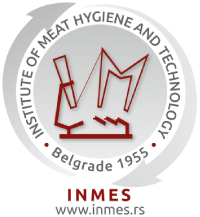Determination of weight loss and temperature of broiler carcasses during air cooling with intermitten water spraying - case study
Abstract
The aim of this study was to determine the broiler carcasses weight loss and temperature during air cooling with intermittent water spraying (3.1 m sec-1, -1.5°C, 120 min) in order to optimize the poultry chilling process. Weight and temperature of broiler carcasses were measured before and after cooling. Measurements were made once a week (during six weeks) on randomly selected broiler carcasses (eight carcasses per week) on the slaughterline. The most common broiler hybrids on the domestic market were used in the study (Ross-308, Cobb 500), of different ages (34 to 41 days old), which had been transported 70 to 260 km to the slaughterhouse. In broilers originating from flocks with higher average bird live body weight (2.2 to 2.4 kg), which were held longer (41 days), slight weight losses of carcasses occurred (0.32 to 0.76%) after cooling. On the other hand, broilers which were held 34-38 days with smaller average bird live weight (1.58 to 2.1 kg) produced slight increases in carcass weights after cooling (0 to 2.18%). Temperatures of the broiler carcasses before cooling ranged from 33.00 to 41.37°C and after cooling were from 1.58 to 5.46°C. The achieved temperature of broiler carcasses depended on carcass size, and was adequate (0 to 4°C) for broilers weighing less than 2.13 kg, but carcasses of larger birds did not meet temperature regulations. The transport length influenced weight loss of live broilers, but did not affect the weight loss of broiler carcasses after cooling. Also no differences were observed in accordance to the broiler hybrid type used (Ross-308, Cobb 500).





